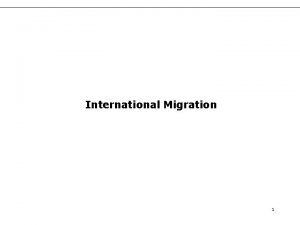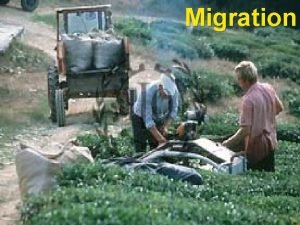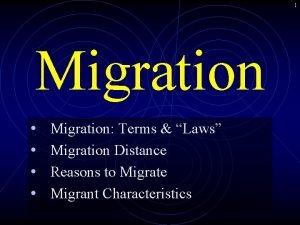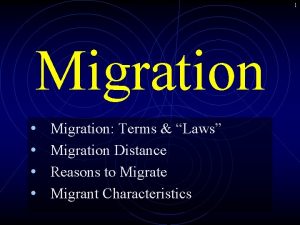How do trends in international migration influence the













- Slides: 13

How do trends in international migration influence the internal mobility of foreigners in Switzerland? Mathias Lerch University of Geneva Institute for demographic and life course studies

Introduction l l l Net internal migration is the major determinant of demographic trends in 80% of the Swiss regions Immigrants represent a fifth of the 7, 7 millions residents and have a higher propensity to migrate internally than natives Immigrants’ internal mobility constitutes a secondary movement after settlement >> How do dynamics in immigration affect the redistribution of migrants in Switzerland ?

Swiss immigration regime and context Spatial inertia of immigrant distribution (2000 -4)

Factors of internal mobility, successive immigrant cohorts and generations

Definitions l Data l l Immigrant = foreigner, admin. def. of length of residence (at least one year) 1 st generation = granted first permit at age 16 and more Internal migration = change of SM region (N=106) Annual Central Aliens registers (stocks & flows) Deterministic & probabilistic record linkage (1981 -2004) Iterative : stock’ 81 to flow’ 81 to stock’ 82 to flow’ 82 … to stock’ 04 to flow’ 04 ~1 million individual residential trajectories:

Methods l Decennial decomposition of crude internal migration rate differentials, measuring the contribution of : – – Changing structure of immigrant population according to length of residence Evolutions in duration-specific migration rates l According to nationality l Mapping spatial focus of internal migrants

Recent immigration inflated the mobility of 1 st generation stock, in the early 1990 s

Lower immigration, but more mobile immigrant cohorts in 2000 -4

Different immigration regimes according to nationality and internal mobility l IT & SP: less immigration, family reunified, low level of mobility, second generation l Ex-Y: inflation due to numerous arrivals, mainly family members who move less l DE & others: higher inflow recently, highly skilled arrival cohorts, very mobile

Increasing spatial focus of internal migration towards main agglomerations and their periphery Migration efficiency indexg

2 nd generation immigrants migrate more than recent immigrants

Conclusion l l Internal migration of foreigners increased because of quantitative and qualitative dynamics in international immigration (role of migration policy) Foreigners’ mobility converge to the Swiss’ patterns Internal redistribution sustained structural change in the Swiss economy, as well as regional economic dynamics Places facing internal departures of natives and ageing could not entirely retain immigrants from abroad

Thank you for your attention !
 Immigration ap human geography definition
Immigration ap human geography definition Trends in international marketing
Trends in international marketing Recent trends in international trade
Recent trends in international trade đặc điểm cơ thể của người tối cổ
đặc điểm cơ thể của người tối cổ Tỉ lệ cơ thể trẻ em
Tỉ lệ cơ thể trẻ em Các châu lục và đại dương trên thế giới
Các châu lục và đại dương trên thế giới ưu thế lai là gì
ưu thế lai là gì Thẻ vin
Thẻ vin Môn thể thao bắt đầu bằng chữ f
Môn thể thao bắt đầu bằng chữ f Tư thế ngồi viết
Tư thế ngồi viết Cái miệng bé xinh thế chỉ nói điều hay thôi
Cái miệng bé xinh thế chỉ nói điều hay thôi Hát kết hợp bộ gõ cơ thể
Hát kết hợp bộ gõ cơ thể Cách giải mật thư tọa độ
Cách giải mật thư tọa độ Từ ngữ thể hiện lòng nhân hậu
Từ ngữ thể hiện lòng nhân hậu

























